 Image search results - "shin" Image search results - "shin" |

Established in 1617, Tsukiji Hongwanji temple is the Tokyo headquarters of the Nishi Hongwanji Jodo Shinshu sect. The present temple, based on Indian architecture, was built in the 1930s.The temple is the only one in Japan which is under the direct control of the sect. Its head priest is the Monshu Abbot himself. April 8 is observed as Buddha's birthday, called Hana Matsuri ("Flower Festival) in Japan.
|
|

Nose Myokenzan Betsuin at a street corner. In Feb., priests at this small temple splash cold water on themselves for 30 min. Near Honjo-Azumabashi Station on the Toei Asakusa Line or JR Kinshicho Station on the Sobu Line.
|
|
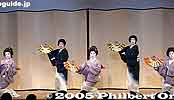
"Hana no Kai" Dance by Kagurazaka geishaThe "Hana no Kai" geisha dance is held annually by geisha in Kagurazaka, one of Tokyo's major geisha districts. "Hana" means livley or gaudy. And "Kai" can mean gathering or party.
They held two shows on the same day. This was the second show starting at 3 pm on April 16, 2005. It lasted till about 4:45 pm.
|
|

Tsukiji Hongwanji temple gate with wisteria crest.The emblem is a wisteria flower and symbol of the Jodo Shinshu sect.
|
|

Shrine hall
|
|

"Blue Ocean Waves" (青海波)They performed four numbers. This first one was called "Blue Ocean Waves" performed by five geisha.
|
|
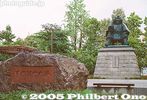
Park in front of Kofu Station.
|
|

Temple gate and flag
|
|

Barrels of cold water in front of shrine
|
|

Notice that the kimono design shows waves.
|
|

Statue of Takeda Shingen.
|
|

Play room for kids on Hanamatsuri
|
|

Barrels of cold water
|
|
|

Hanamatsuri altar
|
|

The congregation gather on the steps and beat fan-shaped drums.
|
|

Rear view
|
|

Pouring sweet tea over the BuddhaWhen the Buddha was born in Lumbini Garden in Nepal, sweet rain is said to have fallen. Thus, sweet tea is poured over the baby Buddha statue in the Hanamatsuri altar.
|
|

Priests appear
|
|

Shimada hairstyleStandard hairstyle for geisha. This a wig.
|
|

Hanamatsuri celebrates the Buddha's birthday on April 8. This is Tsukiji Honganji in Tokyo.The flowers symbolize Lumbini Garden where the Buddha was born in present-day Nepal.
|
|
|

Music and singing accompanimentAll numbers was accompanied by live music and singing.
|
|

Baby Buddha statueLadles are provided for pouring the sweet tea over the Buddha. Sweet tea is also provided to worshippers. It symbolizes the sweet rain that fell when the Buddha was born.
|
|
|
|
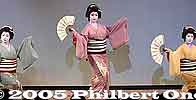
Eight Views of Tatsumi (巽八景)The second number was about the Tatsumi and Monzen-nakacho (Fukagawa) district in Koto Ward, Tokyo. The dance reflects the chic and bravado of the area (in the old days) which was one of Tokyo's gay quarters with geisha as well.
|
|

Children dressed for the chigo parade, Tsukiji Hongwanji, TokyoIt took a long time before they could get all the kids to settle down for the picture and to get all the mothers out of the picture.
|
|
|
|
|

Children dressed for the chigo parade (photo session), Tsukiji Hongwanji, Tokyo
|
|
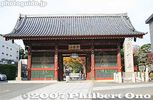
Belonging to the Buzan School of the Shingon Sect of Buddhism, Gokokuji Temple was built by the mother of Shogun Tokugawa Tsunayoshi in 1682. The Gekkoden Hall was moved here from Miidera temple in Otsu, Shiga Pref. The Tahoto Pagoda was modeled after the Tahoto at Ishiyamadera in Otsu, Shiga. Okuma Shigenobu, founder of Waseda Univ., is also buried here. This is the entrance to Gokokuji Temple, Niomon Gate. It's right next to Gokokuji Station on the Yurakucho subway line. 仁王門
|
|

Nagahama Hachimangu Shrine torii on New Year's Day. Nagahama's most popular shrine for New Year's worship (hatsumode). MAP
|
|

Several groups perform along the main road on the east side of JR Shinjuku Station. This is in front of Isetan Dept. Store.
|
|

People coming to Takahata Fudoson temple on Feb. 3, Setsubun day.
|
|

Belonging to the Shingon Sect's Buzan school, this is one of Tokyo's major temples. The real name is Sojiji (總持寺), but everyone calls it Nishi-Arai Daishi.The temple grounds feature many flowering trees and plants including an unusual species of cherry blossoms which bloom in winter. Daishi-mae Station. Much larger station than I expected. Probably for the New Year's crowds. 大師前駅
|
|

Chanting prayers
|
|
|
|

Going to the chigo parade's starting point
|
|

After you pass through the Niomon Gate, this is what you see.
|
|

Takahata Fudoson temple entrance 高幡不動尊
|
|

A large crowd watches as the crowd-pleasing drummers bring a bit of Okinawa to central Tokyo.
|
|

Daishi-mae Station 大師前駅. Nishi-Arai Daishi Temple was said have been founded by Priest Kobo Daishi in 826. One of the Kanto Region's Big Three Daishi Temples.
|
|
|

Tagata Shrine torii and entrance 田縣神社
|
|
|
|

White elephant to anchor the parade. Notice the Buddha altar riding on the top. Before she gave birth to the Buddha, Queen Maya dreamed of a white elephant.
|
|

Well
|
|

Path to shrine with stone lanterns, and cars.
|
|

The setsubun bean-throwing starts with a memorial service, then a procession of the bean throwers and priests.
|
|

Many women drummers also perform. Shinjuku Eisa Matsuri, Tokyo
|
|

The main path to the temple is lined with the usual shops, but it is not aligned with the train station. The path from the train station takes a different route.
|
|
|

Tagata Shrine stone marker
|
|

Her big round eyes makes her look like a real doll.
|
|

Unlike geisha dances in Kyoto which have elaborate backgrounds, the background here is quite plain, making us focus on the geisha which were enough eye candy. The background really didn't matter. The dances were very aesthetic and pleasing to the eyes and ears.
|
|

Start of the Hanamatsuri parade which also promotes traffic safety.The starting point was a nearby park.
|
|

Well
|
|

Stone lanterns
|
|
|

Priests in setsubun procession within the temple grounds.
|
|

Main path to temple
|
|
|

Mikuji paper fortunes for love and romance, marriage, and childbirth.
|
|
|

Parade starts...
|
|

Map of temple grounds. Belonging to the Buzan School of the Shingon Sect of Buddhism, Gokokuji temple was built by the mother of Shogun Tokugawa Tsunayoshi in 1682.
|
|
|

Shinjuku Eisa Matsuri, Tokyo
|
|

Priests in setsubun procession within the temple grounds.
|
|

Sanmon Gate, the main gate. 山門
|
|

Priests splash cold water over themselves at the Nose Myokenzan Betsuin in Sumida-ku, Tokyo
|
|

Tagata Shrine Honden main hall. Komaki, Aichi Pref.
|
|
|
|

Baton-twirling club from the Chiyoda Jogakuin Junior/Senior High School followed by the elephant千代田女学院
|
|

Steps going up to an inner gate called Furomon 不老門
|
|

The shrine grounds was filled with cars on New Year's Day. Apparently, the shrine has no parking lot.
|
|

Priests in setsubun procession coming through Niomon Gate
|
|
|

Sanmon Gate
|
|
|

Tagata Shrine Honden main hall which worships shrine worships a deity called Tamahime-no-Mikoto who was a daughter of a powerful local lord from the 5th century.
|
|
|

Chigo children
|
|

Furomon Gate (Ageless Gate) 不老門
|
|

Another entrance to the shrine
|
|

Hachimangu Shrine torii
|
|

Priest blowing a conch shell
|
|
|

Food stalls lead you to the main worship hall.
|
|
|

Torii to Oku-no-miya Shrine, next to the Honden main hall.
|
|

Closing curtain
|
|

On the road in front of the temple
|
|

View from Furomon Gate
|
|
|

Hachimangu Shrine torii
|
|

Priests in setsubun procession coming through Niomon Gate
|
|
|

Dai-Hondo Hall, Nishi-Arai Daishi, Tokyo 大本堂According to legend, when prayers were offered to save villagers from an epidemic, pure water gushed out of a hitherto dried-up well and got rid of the plague. Since the well was on the west side of the temple hall, this area came to be called "Nishi-Arai" (New Well in the West). The temple is famous for warding off fire and misfortune.
|
|
|

Stones and Oku-no-miya Shrine
|
|

IntermissionThis Ushigome-Tansu Kumin Hall can hold almost 400 people. Both shows were sold out. Tickets are sold about a month in advance. They sold out within 2 weeks. I was sitting in the middle of the hall (non-reserved seating). Tickets cost only 2,000 yen.
|
|

Baton-twirling club, Tsukiji Hongwanji, Tokyo 千代田女学院 バトン部千代田女学院
|
|
|
|
|

Hachimangu Shrine
|
|

Festival beauties included.
|
|

Hand drum
|
|

Incense burner
|
|
|

Chestnut Rice Cakes (栗餅)The third number was called "Chestnut Mochi." Mochi is rice cake. They pound sticky rice to make it. Performed by two geisha. The one in blue is a male role.
|
|

Female schoolmates of the baton twirlers block the cameras of unrelated photographers when the baton twirlers passed. カメラ小僧を妨害するバトン部の先輩たち。This was the first time for me in Japan to see people blocking photographers from taking pictures at a festival. They did it to me as well. If they don't want to be photographed, why do they appear in this public festival??
妨害しても無駄だと思いますが。撮られるのがいやでしたら、まつりに出ない方がいいですよ。
|
|
|
|

Haiden hall 拝殿
|
|

Hachimangu Shrine. Do not climb on the horse.
|
|

Temple priest
|
|
|
|

Sanmon Gate 山門
|
|
|

Lantern
|
|

Filled with a water hose
|
|

This is what you see inside Oku-no-miya Shrine. A giant wooden phallus offering.
|
|
|
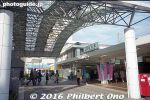
JR Yamashina Station
|
|

Band from the Chiyoda Jogakuin Girls Junior/Senior High SchoolNo problem photographing them.
|
|
|

Ice sculpture of two rats. 2008 is the year of the rat.
|
|

The cherry blossoms lining Sotobori Moat also look stunning from the road, Sotobori-dori in front of Kagurazaka.
|
|

JR Gotanda Station, east entrance 五反田駅
|
|

Names of the bean throwers.
|
|

Infectious Okinawan beat. Shinjuku Eisa Matsuri, Tokyo
|
|

Nagahama's most famous temple belongs to the Jodo Shinshu sect, Otani school. Omotesando path to Daitsuji.
|
|

Hosenji temple in Nakano-ku, Tokyo. Belongs to the Shingon-shu Sect, Buzan School. 宝仙寺
|
|

Trout fishing ponds for customers in warmer months.
|
|

Dai-Hondo Hall 大本堂
|
|
|

Oku-no-miya Shrine also has many other phallic objects presented as offerings. There even one which you can touch...
|
|
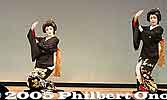
Lively Colors of Kagurazaka(神楽坂華の彩)The final number, called Lively Colors of Kagurazaka (Kagurazaka Hana no Irodori) actually consisted of seven dances. This was the first one performed by three geisha. (ひと里)
|
|

The elephant follows the band.
|
|
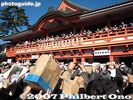
Start of setsubun bean throwing (mamemaki) by minor celebrities. 豆まき
|
|

Buddha statue with Tahoto Pagoda in background
|
|
|

People in a long line waiting to enter Canal Cafe to either dine or rent a rowboat.
|
|
|
|
|

Omotesando is lined with shops.
|
|

Hondo hall 本堂
|
|

Riverside fishing ponds
|
|

Altar inside Dai-Hondo Hall 大本堂
|
|
|

Apparently it can become erect too. (Compare with previous photo.)
|
|

Keihan Yamashina Station is right next to JR Yamashina Station on the right.
|
|

Kagurazaka geisha dance
|
|

Entering the temple gate
|
|

Kannon-do main worship hall 観音堂(本堂)Gokokuji Temple has held large funerals for some famous people like singer Yutaka Ozaki in 1992.
|
|

Honden Hall 本殿
|
|

Canal Cafe is right below the cherries. But notice empty tables despite the long line.
|
|

JR Gotanda Station, east entrance 五反田駅
|
|

Miss Nippon
|
|
|

Red paper umbrellas decorate the path.
|
|

Hondo hall 本堂
|
|

View from Dai-Hondo Hall
|
|

Phallic objects
|
|

Kagurazaka geisha dance
|
|

Final performance
|
|

Kannon-do main worship hall 観音堂(本堂)
|
|

New Year's prayers amid snow.
|
|

Empty rowboats too.
|
|

JR Gotanda Station as seen from Keihin Kyuko Gotanda Station.
|
|

Miss Nippon throw beans, but not very far.
|
|
|
|
|

Kobo Daishi statue
|
|

Winter-flowering cherry blossoms
|
|

Note that the phallus is not the object of worship. It is an offering to the god.
|
|
|
|

Cherry trees along the Sotobori Moat. Formerly a moat of Edo Castle, this canal stretching from Iidabashi Station to Ichigaya Station along the Chuo Line.
|
|

The parade was over after 30 min. (11:30 - 12 pm).
|
|

Daibutsu Buddha statue
|
|

Buying omikuji fortune paper
|
|

JR Gotanda Station, east side
|
|

Kimono beauties and beans do mix well.
|
|
|
|
|

Inside Hondo hall 本堂
|
|

Winter-flowering cherry blossoms and Dai-Hondo Hall
|
|
|
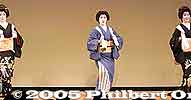
引けや引け引け
|
|

Chigo kids enter the temple
|
|

Daibutsu Buddha statue
|
|

Shrine souvenirs
|
|
|
|

JR Gotanda Station, east side
|
|

Women in kimono is a must on Setsubun day.
|
|

Dancing in front of JR Shinjuku Station, East side
|
|

Sandal store
|
|

Inside Hondo hall 本堂
|
|
|

Votice tablets written with people's wishes for love, sex, and babies.
|
|
|
|

Hanamatsuri service inside the templeNotice the Hanamatsuri altar at the center.
|
|

Tahoto Pagoda at Gokokuji temple in Bunkyo, Tokyo. Built in 1938 modeled after the original Tahoto Pagoda at Ishiyama-dera temple in Otsu, Shiga Prefecture. 多宝塔
|
|

Votive tablet
|
|
|
|

JR Gotanda Station, east side
|
|

Minor female idols also on hand to throw beans.
|
|
|

Statue of Hijikata Toshizo from Shinsengumi. 土方歳三像
|
|

Getting closer to the Sanmon Gate
|
|

Three-story pagoda 三重塔
|
|

Winter-flowering cherry blossoms, Nishi-Arai Daishi, Tokyo 寒桜
|
|

Place to rub the sacred balls. 珍宝窟
|
|
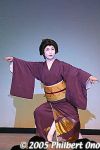
Mt. Fuji and Mt. Asama(富士や浅間). Solo dance by a geisha named Mari(万り).
|
|

Hanamatsuri service inside the Tsukiji Hongwanji temple
|
|
|
|
|

Rowboats and low-hanging cherries.
|
|

JR Gotanda Station, east side
|
|

節分会に吉井怜、三津谷葉子、福下恵美が豆まく
|
|
|
|

Statue of Hijikata Toshizo. 土方歳三像
|
|

Omotesando as seen from Sanmon Gate.
|
|

Goeido Hall housing Kobo Daishi image. 御影堂
|
|
|
|
|
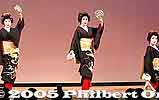
The Word Called Love (恋と云う字)
|
|

Hanami-do housing a statue of the baby Buddha on which sweet tea is poured. When the Buddha was born in Lumbini Garden, flowers bloomed.
|
|
|
|
|

The end of the moat is also a good viewpoint.
|
|

Route 1 in Higashi-Gotanda
|
|

Bikini idols Yoshii Rei, Mitsuya Yoko, and Fukushita Megumi throwing beans on Setsubun
|
|
|

Rear view of Hijikata Toshizo statue
|
|

Daitsuji temple Sanmon Gate 山門
|
|

Temple grounds as seen from the Hondo Hall
|
|

Winter-flowering cherry blossoms 寒桜
|
|
|

Shinsengumi monument 新選組両雄の碑
|
|
|
|

Praying to the Hanamatsuri altar
|
|
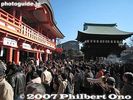
After the first bean-throwing session.
|
|
|

Torii to Benzaiten Shrine
|
|

The end of the moat is also a good viewpoint.
|
|

JR Gotanda Station, east side
|
|

Smoking dragon dance
|
|

2006 NHK Taiga Drama "Komyo ga Tsuji" Exhibition banner and gate entrance.
|
|

Pagoda and pile of setsubun boxes
|
|
|

Rub the two balls.
|
|
| 5103 files on 21 page(s) |
1 |
 |
 |
 |
 |
|